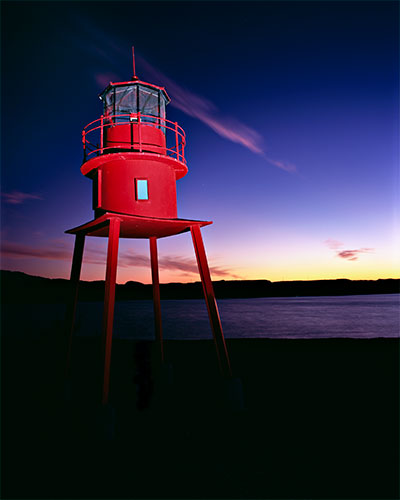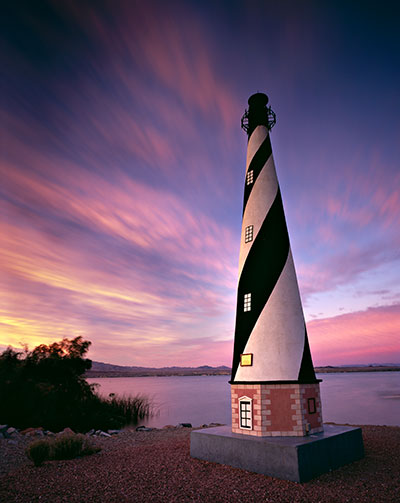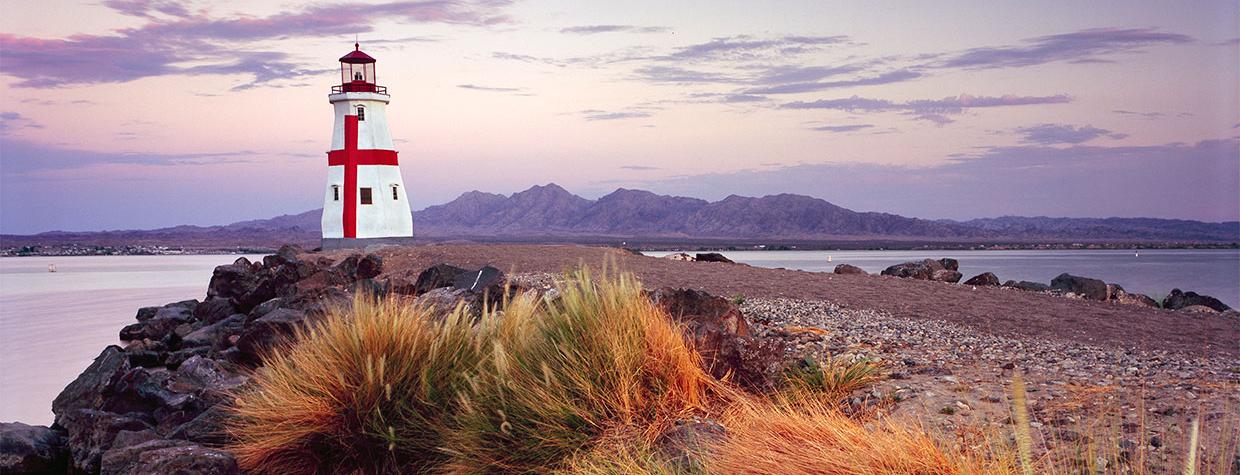
Coastal cities and towns are sometimes known for their charming lighthouses, which help guide boats and keep people safe as they go into and out of the water. In Arizona, the same concept is at play in Lake Havasu City, where a group of volunteers decided more than 20 years ago that Lake Havasu needed something to ensure that nothing tragic happened along the shoreline.
“I moved here 22 years ago, and I had a friend who bought a boat here,” says Lyndia LeCours, a member of the Lake Havasu City Lighthouse Club. “We started around the island when it was daylight, and when we got back, it was black. You could see nothing. For me personally, it was the scariest ride I ever took.”
Rides like that one highlighted the need for navigational lighting, leading to the Lake Havasu City Lighthouse Club’s founding in 2000. The all-volunteer club brainstormed ways to add lighting for boat safety and came up with an idea: lighthouses. But not just ordinary lighthouses. The club took inspiration from famous lighthouses along the East and West coasts of the United States and Canada, as well as the Great Lakes, and built scaled-down replicas.
“[Members] reached out to people and asked if they could sponsor a lighthouse, and the person chose to pay the cost to build it and decide which replica they wanted,” LeCours says.

There are 28 lighthouses along the lake and the city’s man-made island, and each has a story about where the design originated and who sponsored it. Many of the sponsors either are from the area of the original lighthouse or have some other connection that makes the structure special to them. The main difference between the originals and the replicas is size: Most of the replicas are dramatically shorter than the buildings that inspired them. The structures on the west side of Lake Havasu are modeled after West Coast lighthouses and use green beacons, while the east side of the reservoir has East Coast replicas with red beacons. The Great Lakes replicas are situated around the island.
All of the lighthouses were funded through donations and built from scratch. The first, West Quoddy, modeled after a lighthouse in Maine, was installed in June 2002. The most recent, Angel’s Gate, was installed in January 2020. Each lighthouse took two to three months to design and build, and the club’s 35 to 50 volunteers are responsible for maintaining the lighthouses.
“We do monthly inspections and see what needs repairing and cleaning,” LeCours says. “If somebody tells us such-and-such lighthouses aren’t working, we have a group that goes out and makes sure they are.”
LeCours says that while the lighthouses are a draw for visitors, their most important purpose is keeping people safe. All of the buildings are approved by the U.S. Coast Guard and meet navigational safety standards. “I’ve had at least three people that I know attribute the lighthouse to saving their life,” LeCours says. “They serve a great purpose of safety on our lake and river.”
For those interested in touring and photographing the lighthouses, the visitors center offers a map with locations and directions on how to access the structures. Some can be driven or hiked to, while others are accessible only by boat. Private tours, offered throughout the year, give people an up-close view of the structures. And while visitors can go right up to the lighthouses and touch them, they cannot go inside.
There are no plans to add more lighthouses along Lake Havasu, but anyone interested in volunteering or donating to the upkeep of the buildings may contact the Lake Havasu City Lighthouse Club.
Lake Havasu City Lighthouse Club
928-855-4819, lh-lighthouseclub.org

